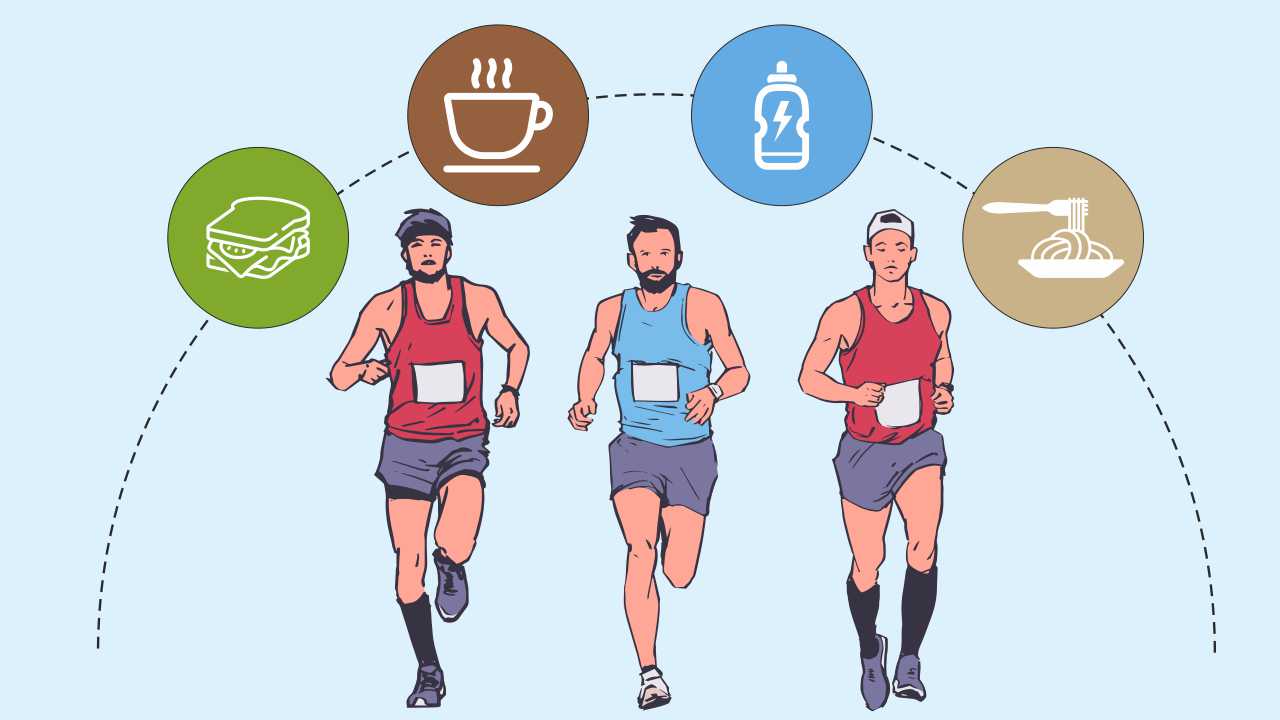
How to Plan for Race Day: Follow These Strategies

You have been training hard for your race for a long time. The competition is just a week away. Now, you need to have a solid full marathon running plan that gives you a reasonable chance to succeed within your goal time. You need to have an idea of certain things to avoid nasty surprises during the competition. Here is a checklist to ensure that you have most bases covered for your race.
Countdown tips: Six days to the race
Here are some things that you may consider doing during this period.
1. Arrive at your goal pace
Download a dynamic fitness app and make optimum use of it. The fitpage mobile app enables you to input your best distance time. For instance, you may enter whether you are planning to train for a 5K or a 10K race. Once you put in this information, our app will give you the approximate finish time for other distances. Now, check the expected finish time for your race against what you achieved in training. Consult your training diary to calculate the average pace in all your long runs. If this matches the estimated pace, then go with it. If not, then decrease the pace to the average that you just calculated. If the goal pace is easily handled in your longest runs, then you are more likely to handle the pace at the event.
2. Practice your goal pace
In one of your runs in the next two-three days, use your goal pace to help your legs develop the muscle memory for it. Also, adapt as per the current heart rate or effort level, so that you are in that mode by the race day.
3. Follow a proper race week training load
During the race week, you need to do around four to five workouts. One of these exercises is a short-duration speed workout. It has a pace similar to a tempo run, wherein your maximum heart rate (MHR) is close to 85%-90%. Another workout is a short run of 40 to 50 minutes at your predicted pace during the race. The other workouts are easy-pace runs.
4. Get familiar with the course
Study the course elevation map carefully. While doing that, check the numbers, locations, and difficulty of inclines. For instance, you need to know if you will have an 8% incline coming up at the 38km mark in a full marathon, which has an approximate distance of 42km. You may experience deep fatigue during this time, and negotiating a steep incline can bring you to a grinding halt. Similarly, analyze how the route is laid. Understand whether it loops around several times or if it is an out-and-back route, or if the finish line is at a different location from the start line.
The route map for the race will also show the location of aid stations. Get an idea of where they are placed and at what distances. The map will specify whether the aid stations will only serve plain water or if they also provide any food or electrolytes
It is advisable to know about these details in advance so that you can do proper planning. For example, if the first location of the aid station serving electrolytes is at the 10km mark, then you may want to carry your electrolytes if you feel that you require fluid before you reach that mark.
The route map will also show you the locations of mobile washrooms. You can access them if you have stomach issues during the race.
5. Seek in-depth information on the items served at aid stations
If you have been training on specific electrolytes and nutrition in your long runs, you may want to know what exactly is served at aid stations. Make it a point to follow the golden rule of not trying anything new on race day. If you get to know that the aid stations are not providing your preferred electrolyte, then you may carry your own gels in a pouch.
6. Read your race instructions carefully
Be well-versed with all the race-related norms. Here are a few things to look out for:
- Find out about the time when the race will start and when you should report to the venue
- Learn about the duration for which the course will be open for the race
- Inquire if you need to reach the start point in the organizer’s shuttle buses; also, check where they start
- Understand the location of the finish enclosure; if it is vast, then identify a spot that you can share with your friends or family members and they can meet you over there; doing this will ensure that you or your loved ones do not get lost
- Check if there is any baggage drop point and whether the finish line is at a different location from the start line; if yes, then find out about the baggage counter located at the finish line
- Verify if there are any specific rules such as no headphones allowed or no permission to accept water or nutritional items from friends or family members during the race
7. Research on the predicted weather for the race day
Your race day attire will depend on the weather. In many cases, you are required to set out very early in the morning and the weather can be quite chilly. However, when the race starts, it can get warmer. So, this indicates that you may have to wear an additional layer over your race attire and later take it off at the venue. If the weather is likely to be hot and humid, then review your race plan to see if you need to change your paces as per the warm weather.
Countdown tips: Three days to the race
When you have just three days left, it’s time to implement some of these useful race tips:
1. Start your carbo-loading and hydration
The body relies on carbohydrate metabolism to get you to the finish line in the best time, but its carbohydrate stores are limited. So, if you are running the full marathon, shift your dietary focus by increasing the intake of carbohydrates and reducing the consumption of protein and fat, so that the overall caloric intake remains the same. The reason for this is to stock up the body’s carbohydrate stores. If you are running the half marathon, start this process two days before the race.
For carbo-loading, your caloric composition should majorly comprise carbohydrates (65%-70%), followed by protein (20%-25%), and fat (10%). Also, hydrate all day so that you have clear urine.
2. Draw a pace chart for the race
Plan a pacing strategy for the race. Use splits into blocks of 5K and create a plan in line with the goal pace. The safest way to go about the pacing plan is to have a strategy for even splits. Here, you run all your splits at a uniform pace. Another alternative is to have a plan for positive splits. Here, you run the second half of the race slower than the first half. If you attempt negative splits, you have to run the first half of the race faster than the second half. In such a case, you may end up developing fatigue and slow down substantially in the second half.
Remember that the first 3km to 5km of your race are about five to seven seconds slower than your goal pace. So, your body can warm up and get into the groove. You will have ample time to make up for these first few slow miles later in the race. The next thing that you need to do is determine the locations of the inclines and to what extent you may have to slow down while reaching those places. Now, incorporate your nutrition and hydration strategy in this plan to know when you need to fuel with electrolytes, water, and food.
3. Plan your travel to the race exhibition (expo) and venue
The venues for the race expo and the race are likely to be different. Make sure you identify these locations and decide on your mode of travel to these venues. If the race is in a different city and you are not familiar with the area, then do a recce of these places to know the exact location.
4. Attend the expo
The race EXPO is likely open for two-three days before the event (race day). So, it is advisable to visit the expo when the crowd is less. Do not forget to carry your race registration confirmation letter and valid identification.
5. Do some stretching
Focus on stretching muscles of the lower extremities, such as glutes, hamstrings, hip flexors, quads, calves, and Achilles tendon. Perform three sets of 20-second stretches for each group of muscles. Static stretching will allow the excess tension to drain out from the muscles, tendons, joint capsules, and ligaments. This will result in complete recovery and reduction in any aches from training load done in the weeks leading to the race week.
6. Sleep
Avoid traveling during the race week. Ensure that you follow a disciplined schedule that permits you to get a good night’s sleep. Sleeping well allows your body to rest and ensures good recovery by restoring the muscles. Sleep is when the body rebuilds and restores muscles. Possibly, you may feel anxious and have a disturbed sleep on the night before the race. However, do not worry, as this nervousness is normal. Focus on sleeping soundly and wake up with a fresh mind.
Also Read: What Role Does Sleep Play in Running Performance?
7. Have a clear visualization of the race
Make a plan on how you will execute your race. Ascertain the pace that you will start at and the changes you envisage over the distance. Self-talk, visualize, and rehearse your race by mentally going over the course. Do this peacefully by lying on the bed and closing your eyes.
Countdown tips: One day to the race
During this crucial duration, you need to focus on:
1. Fuelling and hydration
Here are some dos and don’ts to keep in mind:
- Eat a light dinner
- Hydrate with water and electrolytes to top your sodium and potassium stores
- Stop hydrating about 90 minutes before bedtime to avoid frequent visits to the washroom
- Do not eat gassy foods or extra spicy items, as they may make your gut delicate
- Refrain from consuming alcohol and high-caffeine items, as they may disturb your sleep
2. Getting ready for the race
You need to organize your race apparel. It is recommended to wear the same race apparel that you wore in your longest run. Wearing any new apparel may cause chaffing if you are not used to it. On the night before the race day, assemble your gear, which includes the GPS watch, timing chip, smartphone, shorts, t-shirt, undergarments (sports bra in case of women), shoes, socks, race bib, body lotion, deodorant, sunglasses, cap, sunscreen, hydration sipper, and a belt bag with your favorite foods, gels, and bars.
Gearing up for race day
Finally, the day of the highly anticipated race has arrived. Here are a few guidelines that you may follow:
1. Eat and drink wisely
Do not overeat in the morning before the race begins. However, avoid participating on an empty stomach. The type and quantity of breakfast depend on how much time you have before the race. If you have three to four hours, eat a full breakfast but avoid animal protein, as it takes more time to digest. If you have two hours in hand, eat a snack with some liquid carbohydrates, such as smoothies and juices. Opt for something high in carbohydrates and low in fat, fiber, and protein. Stay away from rich, fatty, or high-fiber foods, as they may cause stomach issues.
2. Reach before the scheduled reporting time
Arrive at the venue early so that you have plenty of time to pick up your number if you have not got it. As you have extra time, use the washroom and do your warm-ups.
3. Include a variety of exercises in your warm-ups
The objective of a warm-up is to gradually raise your heart rate. Ensure that your muscles are supplied with enough oxygen and raise the body temperature to simulate the actual activity. The shorter the race distance is, the longer the warm-up needs to be. Your warm-up can comprise a mix of jogging, dynamic stretches, and running drills.
4. Hydrate smartly
It is necessary to stay hydrated. However, avoid drinking anything 30 minutes before the race starts so that you may visit the washroom one last time if needed. If your race is in the morning, top off your fluids as required once you wake up. If it is at night, drink regularly throughout the day.
5. Start slow
You may be excited to start a race and run at a fast pace. However, this can increase your risk of injuries. So, it is advisable to begin slowly and run at a conversational pace to ensure injury prevention in sports.
Enjoying the race
Training may be a science, but racing is an art. If you have trained diligently and followed the aforementioned pointers on planning your race well, most likely, you will emerge successful. Use the pacing chart that you had prepared and halt at aid stations to fuel up in tandem with your practice during your training long runs. Enjoy the race with the right spirit and keep stress at bay.
Back-up plan for the race
All races do not go as planned. So, you need to know what to do in case things go wrong. It could be that the race day temperature or humidity is higher than expected. So, if your body responds adversely to these conditions, alter your race plan by adding eight to 10 seconds per km for the overall distance. This means that your finish time will be slower than what you had planned. However, it is better than sticking to the race plan, walking the final 10K, or getting a Did Not Finish (DNF). If you misjudge your pace and begin feeling extreme fatigue, slow down and walk for a while. Ensure you consume electrolytes so that dehydration does not add to your woes. Keep the mind and body relaxed with positive thoughts and focus on finishing the race.
Post-race recommendations
As soon as you cross the finish line, stay on your feet and resist the urge to sit down. Walk up to the aid station inside the finish enclosure and hydrate well with water or electrolytes until you feel the urge to pass urine. Your body is craving sugar, and it is wise to eat a snack consisting of carbohydrates and protein as soon as possible. You may eat a full meal after two-three hours.
Also Read: How to Recover Well from a Race
Rest completely for at least two days after your race. Increase the duration of rest if you have run a full marathon. Go for a light massage the next day after the race to relieve aches. You may begin easy pace runs of 40 to 60 minutes later in the week. Start your next phase of training about 10 days to two weeks after the race to ensure total recovery of muscles and tissues. Race day can be a little intimidating, especially if it is your first time. Although enjoying and performing well in a race is not mutually exclusive, being mentally and physically prepared helps you stay calm, healthy, and ready to run at your best potential. So, following these running tips for beginners will prove helpful.














